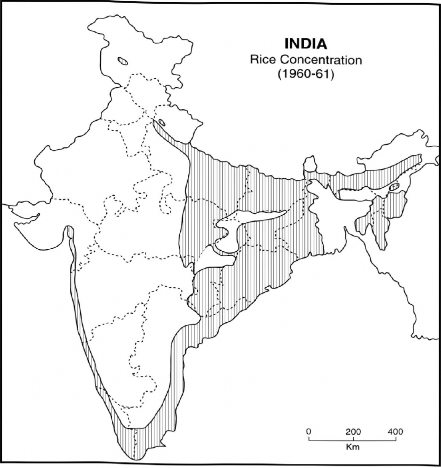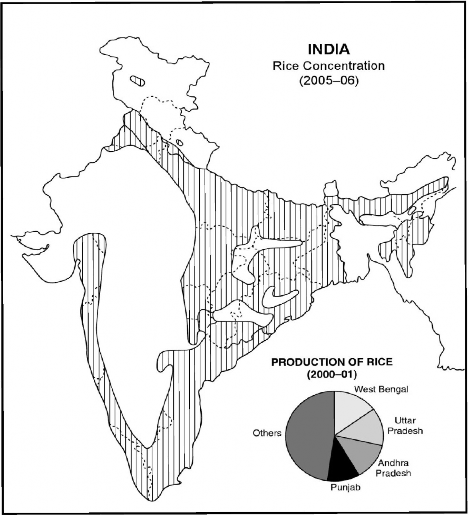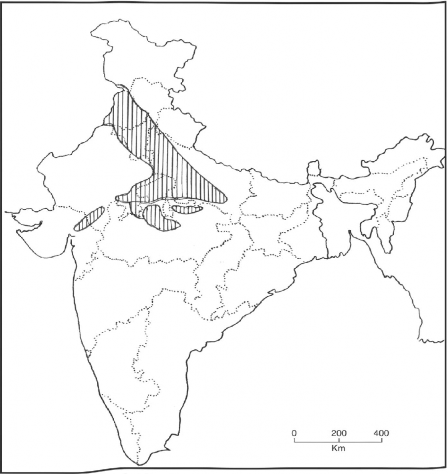9.10 and Fig. 9.11).
A comparison of Fig. 9.10 and Fig. 9.11 shows that rice cultivation has been diffused substantially in the regions of Punjab, Haryana and Western Uttar Pradesh. Interestingly enough, the highest yields of rice are being obtained by the farmers of Punjab who are doing its cultivation with the help of canal and tube-well irrigation. In fact, controlled irrigation in these regions is helpful in achieving high yields per unit area. The percentage change in the area of rice, wheat and other main crops has been shown in Table 9.10.
Table 9.10 Cropping Pattern in 2010-11
Crops | Area in million hectares | Percentage |
Rice | 45.0 | 26.43 |
Wheat | 29.25 | 16.10 |
Jowar | 10.4 | 6.11 |
Bajra | 8.8 | 5.16 |
Maize | 6.4 | 3.76 |
Gram | 6.3 | 3.70 |
Pulses | 21.1 | 12.40 |
Source: Government of India, Ministry of Information: Production Division, India (2012), New Delhi, pp. 71-78.

Fig. 9.10 Rice Concentration (1960-61)
It may be seen from Table 9.10 that over 26 per cent of the total cropped area was under rice and 16 per cent under wheat in 2005-06. Jowar (millet), bajra
(bulrush-millet), and mai& occupied about 6%, 5%, and about 4% of the total cropped area respectively, while the share of pulses was over 12 per cent.
A comparative picture of cereals production in 1950-51 to 2005-06 has been given in Table 9.11:
Ta b Ie 9.11 Production of Cereals, 1950-51 to 2010-11 (in million tonnes)
Crops | 1950-51 | 1970-71 | 2010-11 |
Rice | 30.8 | 37.6 | 95.32 |
Wheat | 9.7 | 18.2 | 85.93 |
Pulses | 12.5 | 13.4 | 28.0 |
(Contd) (Contd.)
Coarse-grains | 15.5 | 31.4 | 30.0 | ||
Total cereals | 78.2 | 101.7 | 341.0 | ||
Total food grains | 97.3 | 124.3 | 241.56 |
Source: Ministry of Agriculture and Economic Survey, 2010-11, and India 2012.

Fig. 9.11 Rice Concentration (2005-06)
It may be seen from Table 9.11 that the production of rice in the country has increased from 30.8 million tonnes in 1950-51 to about 95.32 million tonnes in 2010-11. Although, the production of rice has increased in all the states of the country, it has recorded a phenomenal increase in the states of Punjab and Haryana, mainly because of the adequate and controlled irrigation which are imperative for its cultivation.
Recently, the Indian Rice Research Institute has discovered new varieties of rice that are capable of producing 6-7 tonnes of rice per hectare. This is about three times the average production of rice per hectare.
Wheat is the second most important staple food in India after rice. It contributes about 34 per cent oi the total food grain production in the country. The regional distribution of wheat during the Pre-Green Revolution and Post-Green Revolution periods have been shown in Fig- 9-12 and Fig- 9-13, while Table 9.11 shows the growth of its production.

Fig. 9.12 Wheat Concentration (1960-61)
It may be observed from Table 9.11 that wheat is the only crop in which the production has increased to the maximum, The production of wheat has gone up
85.93 million tonnes in 2010-11 as against only 9.7 million tonnes in 1950-51.
The regional pattern of wheat distribution shows an overall expansion of wheat area from the Ganganagar District of Rajasthan in the west to Dimapur (Nagaland) in the east, and from the Suru and Nubra Valleys (tributaries of the Indus in Ladakh) in the north to Maharashtra, Andhra Pradesh, and even Karnataka in the south (Fig. 9.12).
Looking at the spread of wheat and its excellent performance in the Satluj-Ganga Plains, it may be said that Green Revolution is most successful in the case of wheat. It is because of its high production that wheat has become a commercial crop in Punjab, Haryana and Western Uttar Pradesh.
It may be observed from the Fig. 9.14 that Punjab, Haryana, and western Uttar Pradesh have emerged as the areas of major concentration of rice, while wheat has been diffused in all the directions from its traditional heartland of the north-west India.
Among the other crops, the area yield and production of maize and bajra have gone up. The area and production of pulses have, however, could not have any significant impact of Green Revolution.
